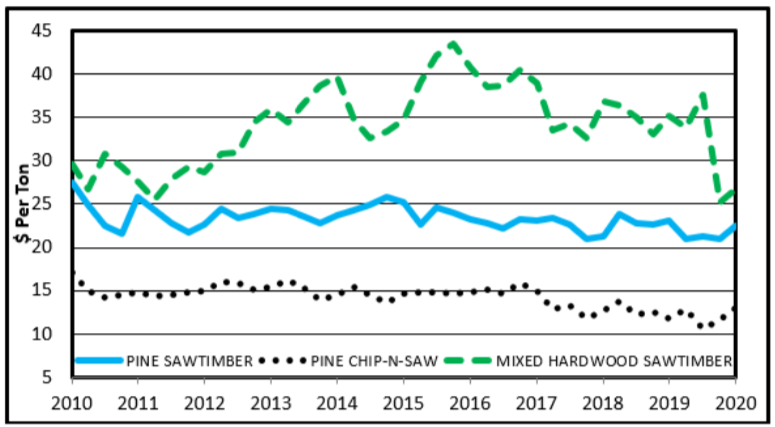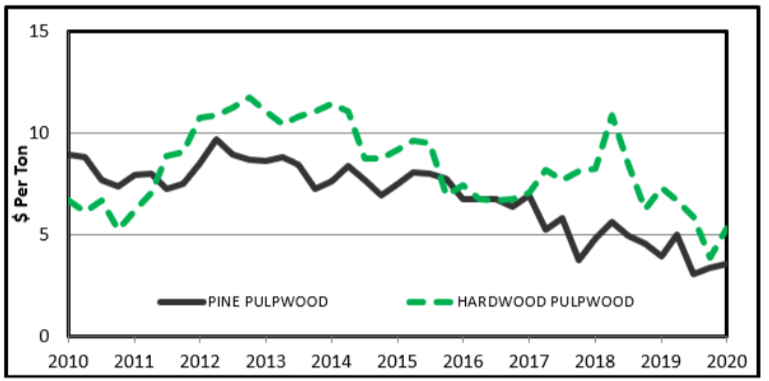Volume 10, Issue 1, February 2021
Extension Forestry Is Here to Help
Brady Self, Extension Forestry Specialist
Considering last year’s far-reaching effects, it should come as no surprise that 2020 was an “off” year for Extension Forestry. Coupled with seven vacant faculty or staff positions and the retirement of Dr. Randy Rousseau last October, COVID-19 pandemic restrictions severely limited our traditional programmatic efforts. However, we adapted to offer a variety of presentations and materials to our clientele. Collectively, the group offered 266 presentations at over 100 programs serving a variety of client groups. In addition, over 100 MSU Extension publications were written or updated and over 30 videos were produced.
Some 2020 highlights include John Auel adapting and moving forward with virtual and in- person offerings of the Professional Logging Manager Program and John Kushla initiating the Kushla’s Korner newsletter focusing on forest management in northeast Mississippi. Shaun Tanger and Marc Measells published a series of publications detailing economic contributions of forestry and forest products for nearly every county in the state. Shaun Tanger and Butch Bailey continue offering programming in the southeast region of the state, with Shaun’s timber tax Mississippi being offered in video form. In addition, Brady Self developed a slate of publications and videos available to individuals wishing to learn about hardwood management.
Our intention is to continue offering traditional services ranging from technical advice in one- on-one settings to short course and workshop trainings as well as virtual offerings when health concerns, operational constraints, and logistical issues dictate. We will provide aid in whatever manner possible and, as the year progresses, expect to initiate more face-to-face offerings as we work through the pandemic. Please bear with us and be assured we truly appreciate your continued support.
State of the Logging Industry in Mississippi
John Auel, Extension Specialist and PLM Program Coordinator
Background
The Mississippi State University Extension Professional Logging Manager (PLM) program is responsible for providing the training necessary for logging companies to be qualified according to Sustainable Forestry Initiative (SFI) requirements for working on SFI certified lands and to deliver to SFI certified mills. Loggers must complete a basic set of classes to become qualified and then maintain that qualification through earning twelve continuing education hours every two years. There are 31 SFI certified companies made up of consuming mills that receive wood severed in Mississippi and owners/managers of industrial forestlands here. Approximately 80%–90% of our annual harvest of forest products is delivered to SFI certified facilities or originates from SFI certified lands. Since SFI certification requires the use of qualified logging companies, the PLM list of qualified logging companies represents most of the loggers in the state.
Current State of the Industry
The overall outlook for Mississippi’s logging industry is positive, despite the ongoing COVID-19 crisis. The effect on individual logging companies is not known, and likely will not be for some time, however the industry as a whole responded well. The health of the logging industry is, obviously, directly related to the forest products markets. Early projections from last summer estimated a 10% or more decrease in production based on COVID-19 restrictions. Given the narrow margins in the logging industry, that loss of production would have devasted many firms. However, 2020 severance tax records, obtained in February 2021 from the MS Department of Revenue, show a forest products harvest increase of almost 1 million tons over the 2019 harvest. Housing starts reached a 14-year record-high in December 2020, and this upward trend was reflected in the 17% increase of pine sawtimber over 2019 numbers. Increases were also noted in the markets for poles and low-grade hardwood timber (crossties, pallets, and the like). The strong economy, prior to as well as the initial recovery early last summer, contributed to maintaining demand for those products and viability of the logging sector in Mississippi.
If the strong economy of 2020, despite the pandemic, can carry forward through 2021 and beyond, the relative health of the Mississippi logging industry, will continue.
The 2020 Harvest of Forest Products is available here.
Delta Hardwood Notes: Herbicide Drift on Hardwood Plantations
Brady Self, Extension Forestry Specialist
Herbicide drift is one of the more visual problems encountered in Delta hardwood plantations. Being the primary agricultural production region of the state, herbicide applications are a fact of life in this region. Regrettably, off-target drift is a common occurrence during spring burndown where herbicides are used to target winter annuals and weed species resistant to crop- friendly herbicides. A large portion of the region’s hardwood plantations are in proximity with agricultural fields undergoing these herbicide applications. Subsequently, questions regarding damage from accidental drift are routine.
Unlike drift damage to agricultural commodities (drops in yield), herbicide damage to hardwood trees is much harder to evaluate and quantify. Often the idea is that if a tree is damaged and lives, it will survive, continue to grow, and successfully fulfill whatever its end purpose is. While that is not necessarily untrue, ultimate damage to a tree depends various factors. Consideration should be given not only to damage severity, but also to its frequency. Even low-level herbicide exposure can have a large cumulative impact to tree vigor and wood quality if repeated over time. One only needs to observe the prevalence of low-growing forks often encountered in hardwood plantations damaged through multiple drift incidences. If timber production is a goal, stands with a high frequency of forking are unlikely to ever reach commercial timber status. In addition, lowering of vigor increases a tree’s susceptibility to other mortality causes including insects and various pathogens. While we do not have enough time to list all considerations, please contact your local MSU Extension agent, or Forestry Specialist with any questions you may have.
Mississippi Timber Price Report - 4th Quarter 2020
Marc Measells, Senior Extension Associate
The Mississippi Timber Price Report provides a picture of timber market activity across the state showing regional and statewide stumpage prices for common forest products. This report should only be used as a guide to help individuals monitor timber market trends. The average price should not be applied as fair market value for a specific timber sale because many variables influence actual prices individuals landowners receive. This report and previous historical timber prices are available by contacting your local county Extension office or at: www.extension.msstate.edu/forestry/forest-economics/timber-prices.
4th Quarter 2020 Stumpage Prices/Ton (Source: MSU Extension)
| Pine Poles | $43.07 |
| Pine Sawtimber | $22.52 |
| Pine Chip N Saw | $12.95 |
| Pine Pulpwood | $3.54 |
| Oak Sawtimber | $35.59 |
| Mixed Hardwood Sawtimber | $26.65 |
| Crossties | $25.00 |
| Hardwood Pulpwood | $5.34 |
NOTE: Prices vary widely across the state; average prices presented here may not reflect your local market.
Price Trends:

sawtimber stumpage prices ($/ton) for 4th quarter 2010 through 4th quarter2020.*

for 4th quarter 2010 through 4th quarter 2020.*
*Prices from 2010-2017 are from Timber Mart-South. 2018-current prices are from MSU Extension.
COVID-19 caused lots of uncertainties and volatility in 2020. However, we look forward to improved timber markets in 2021. As predicted, supply and demand relationships improved during the 4th quarter resulting in some price stability and increases. Prices typically improve during the 4th quarter as wetter weather conditions return. Figures reflect 10-year statewide average price trends.
Compared to the 3rd quarter, statewide average prices increased (0.7% to 37.8%) during the 4th quarter for all product classes. However, prices decreased for some product classes in some regions. Timber sales seem to have increased over the 4th quarter compared to the remainder of the year. Despite record lumber prices during 2020, our abundant oversupply of standing timber continues to be the main contributor to stumpage prices.
The housing market continued its upward trend since reductions in March and April. Additionally, the unemployment rate, although still high, has continually decreased since April. As housing market and unemployment rates continue to improve, timber markets may begin to recover. However, exports of logs and lumber were still down compared to the previous year. Keep in mind, we still face an enormous overabundant supply of standing timber in Mississippi which will restrain stumpage prices moving forward.
Prices during the 1st quarter 2021 are expected to increase slightly, primarily due to our typical winter weather conditions.
Most economic forecasters still expect recovery to be slower, lasting throughout 2021. In addition to mill announcements during 3rd quarter 2020, Hankins Timber announced a new sawmill near Elliott, Idaho Forest Products announced a new pine sawmill in Lumberton with startup planned by 2022, and Biewer lumber announced plans for a new state-of-the-art sawmill located in Winona with startup expected in early 2022. Additionally, mills just outside Mississippi have announced mill expansions which should benefit Mississippi landowners as well. The increased competition from these new mills are much needed!
*Timber-Mart South (TMS), Inc. has more detailed data available by subscription that contains values for other timber products not included in this report. TMS is compiled and produced at the Center for forest Business, Warnell School of Forest Resources, University of Georgia, under contract with the Frank W. Norris Foundation, a non-profit corporation serving the forest products industry. See http://WWW.TMARTSOUTH.COM for information on subscriptions.
Forest Taxation and Other Program Offerings from Southeast Mississippi Extension Forestry
Shaun Tanger, Extension Forestry Specialist
Nonindustrial private forests cover about 360 million acres in the U.S. Most are family owned and cover less than 100 acres. These forests pass generationally, so timber taxes are routinely a top issue for NIPF landowners. Mississippi forest landowners look to MSU Extension Forestry as a source of information on how to properly file taxes and report income along with aid in determining basis, management costs, expenses, and reforestation. Costly filing mistakes are common. Therefore, we have a great opportunity to help forestry clientele file their timber taxes properly.
In this program we educate landowners and forestry professionals on inner workings of federal and state timber taxation. The objective is to allow stakeholders to speak more confidently on taxation issues and allow them to incorporate tax rules into management of their forest properties. This in turn should increase profitability of forest holdings.
I also conduct educational programs, provide information and conduct applied analysis in the areas of supply and demand as well as timber price forecasts in Mississippi and the southern U.S. Specifically, I work to bring new mills to the state and estimate their impact on harvest levels and prices. I conduct analysis for economic impact of forest products industry in the state, congressional districts, and counties while bringing attention to policy issues affecting forest stakeholders.
Lastly, I provide one‐on‐one and group management and financial assistance to landowners for various timber stand decisions. This is done through extension activities including workshops and seminars, as well as through multimedia and printed materials. This also includes phone calls and e-mails with individuals regarding various property decisions and related topics (e.g. price trends, wood using mill locations, identifying consultants and loggers to harvest timber on location).
Primary Business Address
Mississippi State University
Forestry Extension
P.O. Box 9681
775 Stone Blvd
Mississippi State, MS 39762
Contact: Ms. Laura Terry
let181@msstate.edu
662-325-2946
Fax: 662-325-0027
Regional Personnel:
NE District: Dr. John Kushla
662-566-8013, or John.Kushla@msstate.edu
NW District: Dr. Brady Self
662-226-6000, or brady.self@msstate.edu
SW District: *For questions regarding the SW District, please contact Dr. Brady Self at 662-226-6000, or brady.self@msstate.edu
SE District: Mr. Butch Bailey
601-794-0671, or asb1@msstate.edu
SE District: Dr. Shaun Tanger
228-546-1014, or smt489@msstate.edu
Campus Personnel:
Professional Logging Manager, Tree Farm and SFI: Dr. John Auel
662-325-7948, or jba9@msstate.edu
Timber Prices, Economics, Certification: Mr. Marc Measells
662-325-3550, or mkm2@msstate.edu
Media: Ms. Laura Terry
662-325-2946, or let181@msstate.edu




